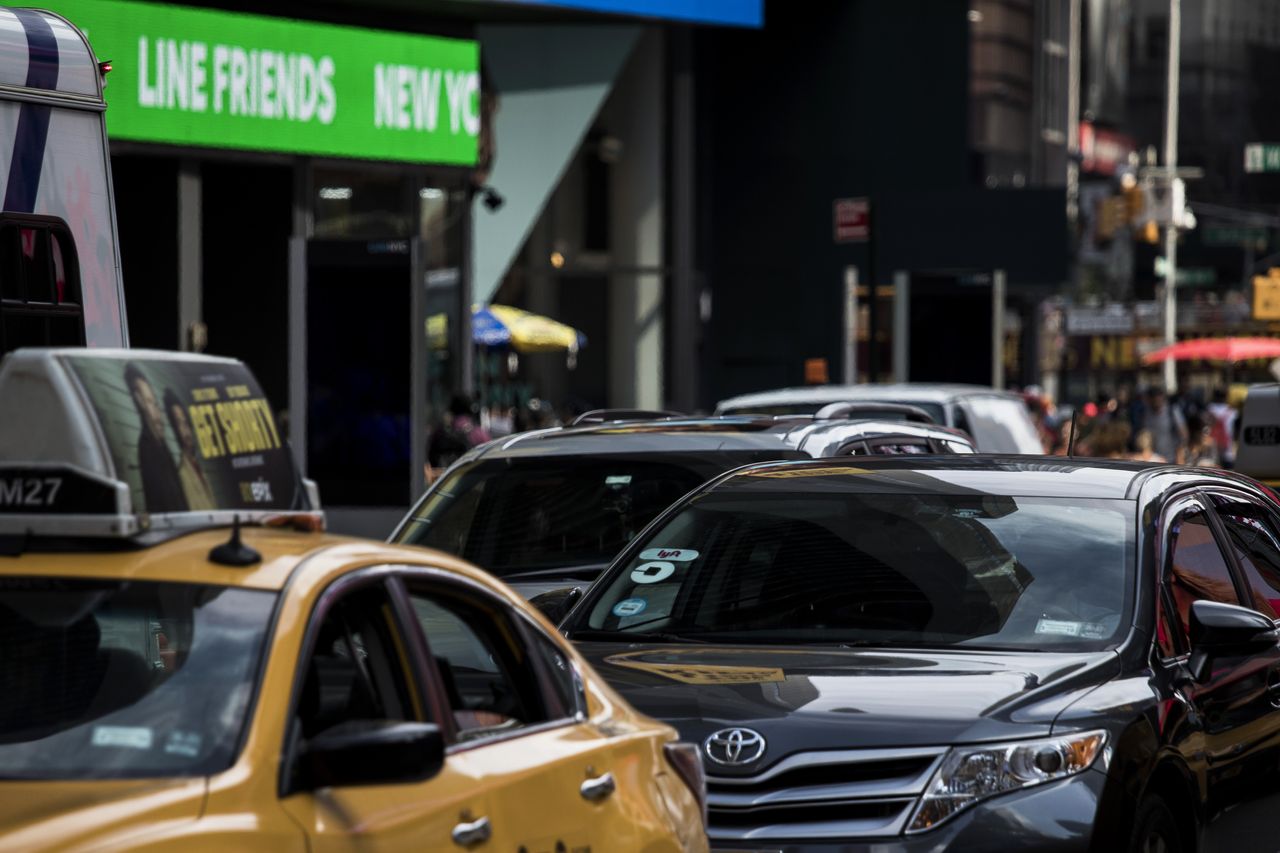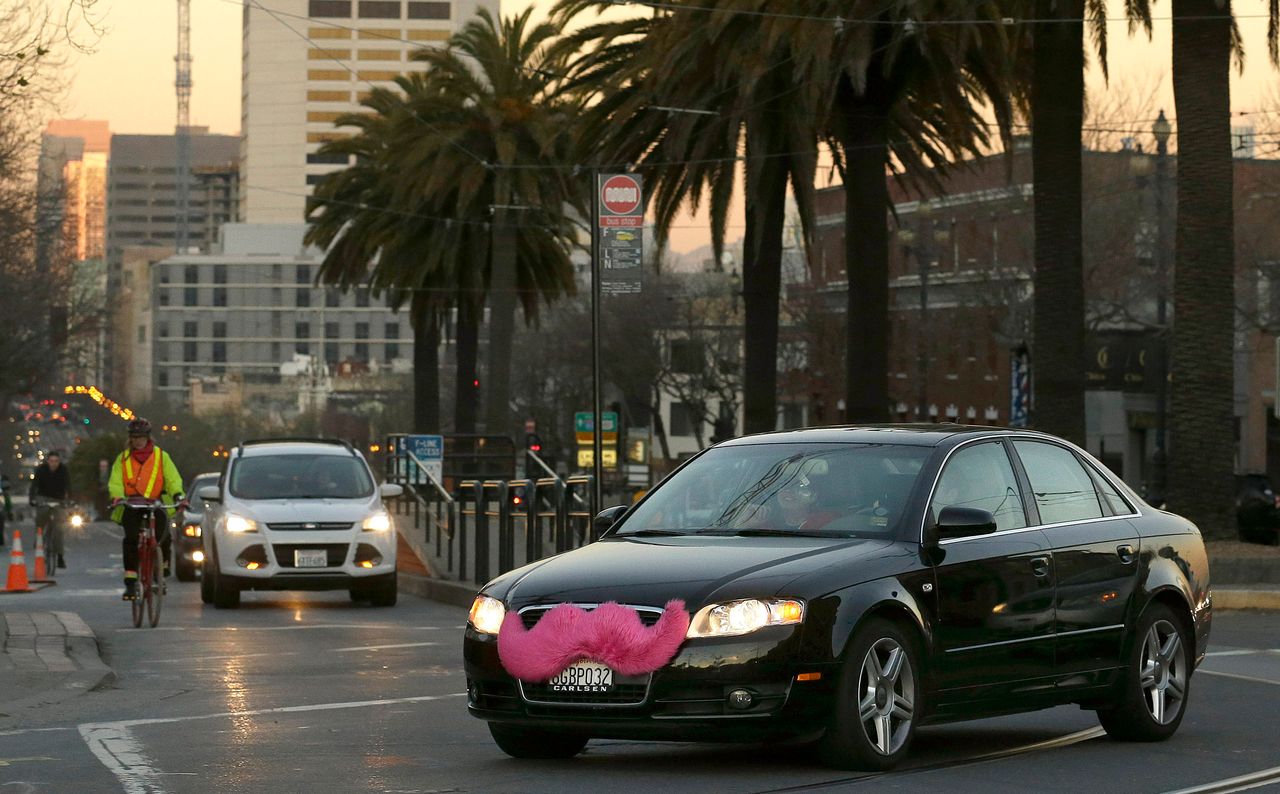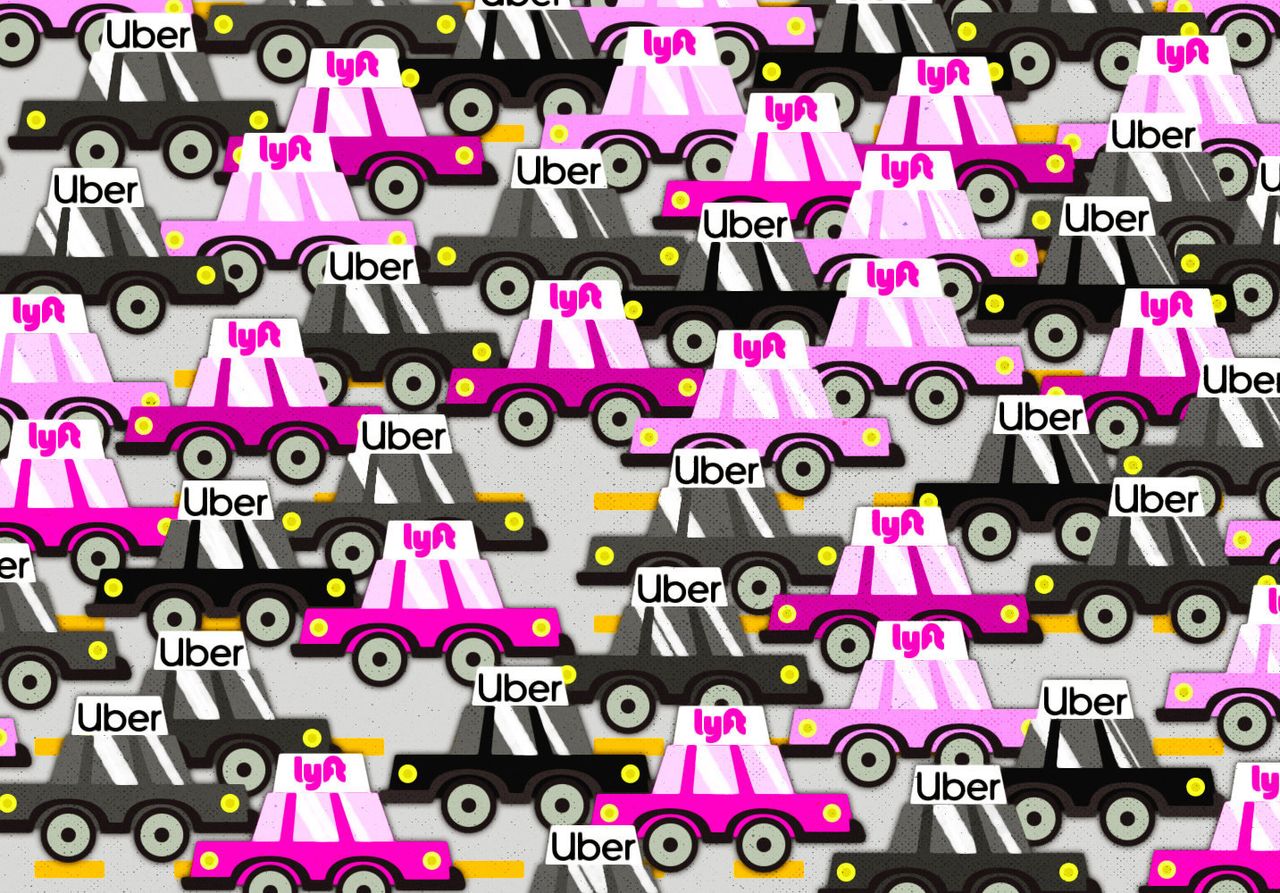For years now, Uber and Lyft have argued that their business model provides a way for cities to augment public transport, reduce car ownership and beat traffic congestion.
In 2015, Uber co-founder and then-CEO Travis Kalanick told a room of CEOs that he envisioned “a world where there’s no more traffic in Boston in five years.” The co-founder of Lyft, John Zimmer, predicted in 2016 that private car ownership “will all-but end in major U.S. cities” by 2025. “If Lyft Line were to be applied to all single occupancy taxi trips,” Zimmer and his co-founder, Logan Green, wrote in 2017, “it would reduce the number of vehicles needed by 75 percent.” They called their post “The End of Traffic.”
But these utopian visions have yet to square with reality. Since 2015, studies have consistently found that ride-sharing is associated with more driving, less public transit use and worsening congestion. Car traffic and ownership rates are still rising and, according to a study earlier this year, up to 60 percent of Uber and Lyft rides replace walking, biking, buses and trains — transportation modes that didn’t add cars to the roads. Just this month, the San Francisco County Transportation Authority concluded that ride-sharing accounted for roughly half of the 37 extra minutes San Franciscans spend sitting in traffic every day compared to 2010.
And the problem is only going to get worse. Taxis and ride-sharing currently account for just 1.7 percent of trips in America’s largest cities, but are growing exponentially. By the end of 2018, Uber and Lyft are projected to carry more people than local bus systems.
And yet, as more information has revealed the relationship between ride-sharing and congestion — and its other negative impacts on cities — Uber and Lyft continue to design products and roll out services almost guaranteed to make it worse.
“They’re deliberately redesigning themselves to compete with public transport,” said Bruce Schaller, a former Deputy Commissioner for the New York City Department of Transportation and the author of a series of studies on ride-sharing. “That means millions of people swapping efficient transport for inefficient transport, and a lot more empty seats driving around cities.”

How More Car Sharing Leads to Worse Congestion
For years, the link between increased ride-hailing and reduced congestion was clear: Cheap, immediate and abundant taxi rides would encourage city residents to give up their cars. Uber Pool and Lyft’s Shared Rides, which pick up extra riders along their routes, would act like city-wide carpooling agencies, combining passengers and extending the reach of public transportation. Plus, since ride-sharing doesn’t require parking, cities could reclaim outdoor car storage for wider sidewalks and protected bike lanes.
But in the last few years, as ride-sharing has expanded to dozens of cities and billions of rides, nearly all of these assumptions have been proven wrong or wildly optimistic.
First, ride-sharing hasn’t reduced the number of cars on the roads. As taxi rides have come down in price, they have boomed in popularity. San Francisco now has over 20 times more ride-share vehicles than official cabs. In New York, registered “transportation network company” cars outnumber yellow cabs six to one. While some city residents have indeed given up their vehicles in favor of car sharing, others have purchased cars specifically to drive for Uber and Lyft. A University of Chicago study published in October found that cities with more ride-sharing had 3 percent higher car ownership rates that those with less ride-sharing.
Second, swapping solo drivers for car shares hasn’t reduced the number of miles city residents are racking up on the roads. “Switching from your own car to an Uber actually adds miles because the car has to come pick you up,” Schaller said. His study from earlier this year found that UberX — one driver picking up one passenger — adds 2.8 vehicle miles to the road for every mile of driving it eliminates.
“It would be great if Uber and Lyft carried small groups of people, but in fact they overwhelmingly carry solo riders,” said Jarrett Walker, a transit planner and policy consultant. Uber drivers have to get to their first passenger, then end up taking significant detours along the route to pick up their second or third. And that’s when they pick up a second passenger at all: According to internal company data obtained by BuzzFeed, 40 percent of Uber Pool trips in San Francisco ended up as solo rides in 2015, a time when Uber was heavily subsidizing fares to make the service more popular. Plus, Walker points out, ride-sharing is only available in a handful of U.S. cities. “And when it is,” he said, “it’s not that much cheaper than solo rides, which is a signal that the idea isn’t really that profitable.”
Third, rather than augmenting and assisting more efficient forms of transportation, Uber and Lyft are poaching from them. Two separate studies have found that the majority of Uber and Lyft riders would have walked, biked or taken public transit if ride-hailing wasn’t available. In one study, a University of Colorado researcher became an Uber driver and surveyed his passengers. Only around one in five, he found, replaced driving alone with his taxi ride.
“When you ask people who say they’re replacing personal auto trips why they take ride-sharing instead, it turns out they’re taking Uber and Lyft to the airport, when they go out drinking and when they travel to avoid renting a car,” Schaller said. “Those are all replacing public transit trips.” Plus, since ride-share passengers tend to be more affluent than city averages, Schaller said, ride-hailing could be enticing the wealthy out of buses and trains altogether, creating a two-tier system and eroding public support and funding for more efficient forms of transport in the long term.
The tech companies’ predictions about parking haven’t come true either. Instead of circling the block looking for spaces, drivers circle the block looking for passengers. In San Francisco, Uber and Lyft account for nearly three-quarters of the increase in congestion in the Financial District, where traffic is already gridlocked, but almost none in the suburbs. The explanation is simple: The demand for taxi rides is highest in neighborhoods where driving and parking are a hassle, namely job centers and cultural hotspots. The more time drivers spend in those neighborhoods looking for fares, the more they’ll get.
And none of this takes into account the broader impacts of ride-sharing on cities. A recent University of Chicago study found that Uber and Lyft may have increased traffic deaths by up to 3 percent. Driver wages, after factoring in the cost of owning a vehicle, could be less than $10 per hour. Both ride-hailing companies have spent years fighting court battles to prevent their drivers from unionizing. Even if their impact on traffic were a net positive, it’s worth asking what cities are giving up to achieve it.

Superficial Actions To Reduce Car Dependency
Not surprisingly, the ride-sharing companies dispute nearly every aspect of the evidence above. In an interview, Lyft spokeswoman Campbell Matthews acknowledged that congestion is getting worse in big cities, but she added that the impact of Lyft and Uber is dwarfed by larger forces such as urbanization, ailing public transit systems and increases in freight and construction activity. She provided links to studies from New York, Chicago and San Francisco indicating that the worst increases in congestion predate the introduction of ride-sharing and pointed out that despite the rapid expansion of Lyft and Uber in the Bay Area, congestion actually fell last year.
Matthews also stressed that Lyft sees itself as a partner to public transit. According to internal data, she said, 56 percent of rides in New York City begin and end outside of Manhattan’s congested core, indicating that ride-sharing serves populations that lack access to frequent bus and train routes. The company is also partnering with transit agencies to provide “last mile” services from the nearest public transit stop to their door. In Monrovia, California, for example, residents can pay just 50 cents for a ride to an LA Metro stop. In Boston, Lyft is partnering with the Massachusetts Bay Transportation Authority to provide paratransit for riders with disabilities.
Uber, which did not respond to requests to comment for this article, has made similar public statements. The company’s CEO, Dara Khosrowshahi, said earlier this year that “The great goal is getting rid of car ownership.” Spokeswoman Alix Anfang told USA Today in February that “Uber’s long-term goal is to end the reliance on personal vehicles and allow a mix of public transportation and services like Uber.”
But both companies’ core products and strategies contradict their respective accounts. Earlier this year, Uber launched “Express Pool,” a service that allows users to catch ride-share vehicles along common routes for just $2 — a price and service nearly identical to a bus route. Lyft’s similar “Shuttle” service is only available during commute hours, the time of day when roads are busiest and the company is most likely to compete with public transit.
“What Lyft wants us to imagine just doesn’t align with their profit motive.”
- Jarrett Walker, a transit planner and policy consultant
Both companies describe their relationships with public transit agencies as “partnerships,” but in reality look more like replacements. In Summit, New Jersey, for example, city leaders are providing subsidized Lyft rides to the commuter train station ― funding that could have been spent on a shuttle service, expanded bus routes or other incentives for local residents to walk or bike to the station. Five cities in central Florida have experimented with giving up on public transit altogether in favor of funding Uber rides, a policy almost certain to put more miles of driving on the road.
“I don’t believe the math that says Lyft can be efficient doing zillions of one- to two-mile trips to transit stops,” Walker said. “Short trips are inefficient and drivers don’t like them. Ever taken a taxi to a transit station and had the driver pitch you on taking you all the way to your destination? What Lyft wants us to imagine just doesn’t align with their profit motive.”
And public transit agencies aren’t the ride-hailing companies’ only partnerships. In nine cities and one state, Uber uses WageWorks to let employees spend their pre-tax income on UberPool rides — a benefit that only applies to commuters and is designed around the destinations and times of day most likely to add to congestion. Uber also works with Getaround, a service that allows car owners to rent out their vehicles when they’re not in use ― and encourages car ownership. Even the company’s marketing undermines mass transit: A 2016 ad depicted a woman on a train platform with the text, “You can’t miss an Uber.”
Other efforts to reduce car dependency have the same superficiality. Earlier this year, Lyft launched the “Ditch Your Car Challenge,” a rewards program for city residents who pledged to give up driving for a month. The company’s founder described it as a “concerted effort to jolt Americans out of their comfort zones and persuade them to give up the convenience of personal car ownership.” Behind the grand rhetoric, however, the program was only available once, to 50 people per city, and appears to have brought back more in earned media than the company spent subsidizing shared rides.
Then there are the numbers. Lyft claims to have enticed 250,000 people to give up their cars in 2017, but that figure is based on a customer survey for which the company has released only a two-sentence methodology. Uber’s claim that it saved more than 315 million global vehicle miles in 2017 is similarly unsupported.
“It’s a way of getting fewer vehicles on the street and deflecting other forms of regulation.”
- Bruce Schaller, a former Deputy Commissioner for the New York City Department of Transportation
When pressed on these discrepancies, Uber and Lyft often point to their political advocacy as an example of their efforts to reduce car ownership and urban congestion. Uber recently announced a $10 million effort to promote congestion pricing — a fee for drivers entering cities’ most gridlocked areas. Lyft has supported similar efforts, and Matthews pointed to the company’s campaigns to replace parking spots with driver pickup areas as examples of its advocacy to reduce traffic.
As Schaller pointed out, however, these policies substantially benefit the ride-hailing companies. “It’s a way of getting fewer vehicles on the street and deflecting other forms of regulation,” he said. Congestion pricing would discourage other limits on ride-hailing such as New York’s recently passed cap on Uber and Lyft vehicles. It would also charge drivers to enter cities but not to take short trips within them, a structure that benefits taxi companies (and encourages rides on scooters and e-bikes, another sector both companies are investing in).
Uber and Lyft’s campaigns to replace parking spaces with ride-hailing spots are even more directly beneficial. Neither company appears to have ever advocated for the removal of car lanes in favor of space for pedestrians, cyclists or public transit. While Lyft participated in an effort to improve the flow of traffic on Valencia Street in San Francisco, its contributions appear aimed at expanding loading zones and improving its drop-off and pickup times. While it’s no surprise that ride-hailing companies lobby for their interests, these efforts seem less about reducing car dependency than simply swapping one form of it for another.
Which is why, Schaller said, policymakers need to step in. As ride-sharing grows and traffic continues to worsen, city leaders need to encourage functioning, efficient, sustainable transit systems. Uber and Lyft, as profit-making enterprises, won’t be compatible with those aims.
The most profitable way to operate in cities, Schaller said, is by swarming the neighborhoods and times of day that are already the most congested. “Uber is doing an IPO in 2019,” he said. “It’s unlikely that they’re going to go green and undercut their profits.”
